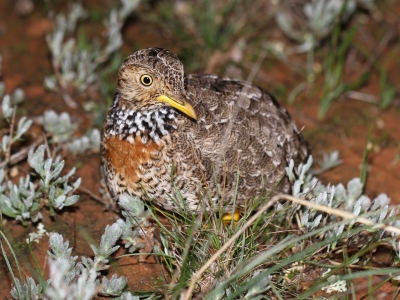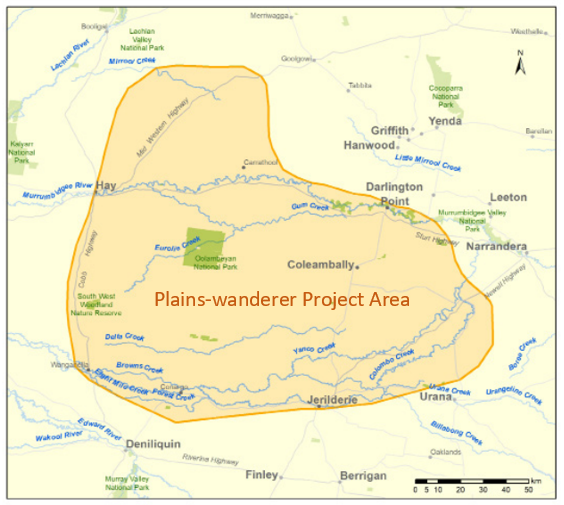Bringing Plains-wanderers back from the brink
The Bringing Plains-wanderers back from the brink project aims to recover the population of the critically endangered plains-wanderer (Pedionomus torquatus) in the region.
Read the 2022 project newsletter (PDF)

About the Plains-wanderer
Plains-wanderers are small, ground-dwelling birds found in sparse native grasslands of the Murray & Riverina. They have a yellow bill and legs, and feathers that are fawn in colour with black rosettes. The sexes differ in appearance, with the female being slightly larger, and she has a black and white collar above a red breast patch.
Plains-wanderers prefer sparse native grasslands, which typically occur on hard red soils. An open grassland structure with around 60% bare ground allows birds to easily move about, find seeds and insects to eat, and to detect and slip away from predators like foxes. Plains-wanderers will disappear from the habitat that becomes too sparse or too dense.
The last couple of decades in the NSW Riverina have been tough for plains-wanderers. There have been long dry periods and some very wet years. This has meant that large areas of habitat have often been too sparse or too thick to support birds, which has caused a steep decline in plains-wanderer numbers. There is estimated to be only 300 birds remaining in NSW and less than 1,000 in Australia.

The Plains-wanderer are threatened due to:
- Loss of native grasslands from clearing and pasture improvement
- Boxthorn which provides perches for raptors and shelter for pests e.g. foxes and rabbits
- Prolonged drought and overgrazing, resulting in a loss of suitable groundcover habitat
- Predation by foxes and feral cats
- Increased frequency and intensity of fire
- Rabbits that cause damage to the habitat.
What can I do?
- Manage habitat to provide equal parts bare ground and plants.
- Let us know of any sightings or if you have suitable habitat.
- Strategic grazing which may require reducing grazing pressure in dry years and increase grazing pressure in wet years.
Through the project landholders have been working to improve the condition of Plains-wanderer habitat on their properties by using strategic grazing management and undertaking pest and weed control. Since the program commenced in 2017, 30 landholders have committed to managing nearly 14,000 hectares of primary habitat.
In addition to the property-scale baiting across the project area supported by the Paddocks for Plains-wanderer incentive program, three landscape-scale intensive predator control programs have been established. To date, it is estimated that over 7000 foxes have been removed from the landscapes.
What is the project doing for plains-wanderers?
We are working with landholders to improve grazing management practices on areas of plains-wanderer grassland habitat. We support landholders to manage paddocks for livestock production and plains-wanderer conservation, by offering incentives for pest and weed control, fencing, water points, saltbush plantations, stock management areas, and feeding infrastructure.
Landscape-scale fox control is also being undertaken over 95,000 ha in the Murray & Riverina.
By improving grazing management of grasslands & controlling predators like foxes, this project will safeguard suitable grassland habitat areas to recover plains-wanderers in the Murray & Riverina.
What can landholders do to help the plains-wanderer?
The most important thing landholders can do is to manage their habitat in ‘Ideal’ conditions. Ideal habitat has roughly equal parts bare ground and plants, with most of the plants being herbs and grasses around five centimetres tall plus a scattering of taller plants.
Grazing is an important tool for achieving this outcome. In some cases, no change to the current grazing regime will be required. In others, landholders will need to reduce grazing pressure in dry years or increase grazing pressure in wet years. The most critical times are during drought, when paddocks may need to be de-stocked completely for extended periods.
Watch what one landholder has done to help save the Plains-wanderers.
More Information
If you wish to know more about plains-wanderers or get involved in the incentive program, please contact:
- Chris Allen on 0407 790 115 or chris.j.allen@lls.nsw.gov.au
- Shanna Rogers on 0457 733 261 or shanna.rogers@lls.nsw.gov.au
Click here to view the Plains-wanderer Habitat Management Guide.
Riverina Local Land Services have produced videos on the plains-wanderer project & the incentive program. Watch the plains-wanderer video or the incentive program video.
For more detailed information on the plains-wanderer, please visit the NSW Government’s plains-wanderer profile.
This project is supported by Murray Local Land Services and Riverina Local Land Services, through funding from the Australian Government’s National Landcare Program and the NSW Government’s Saving our Species program.
